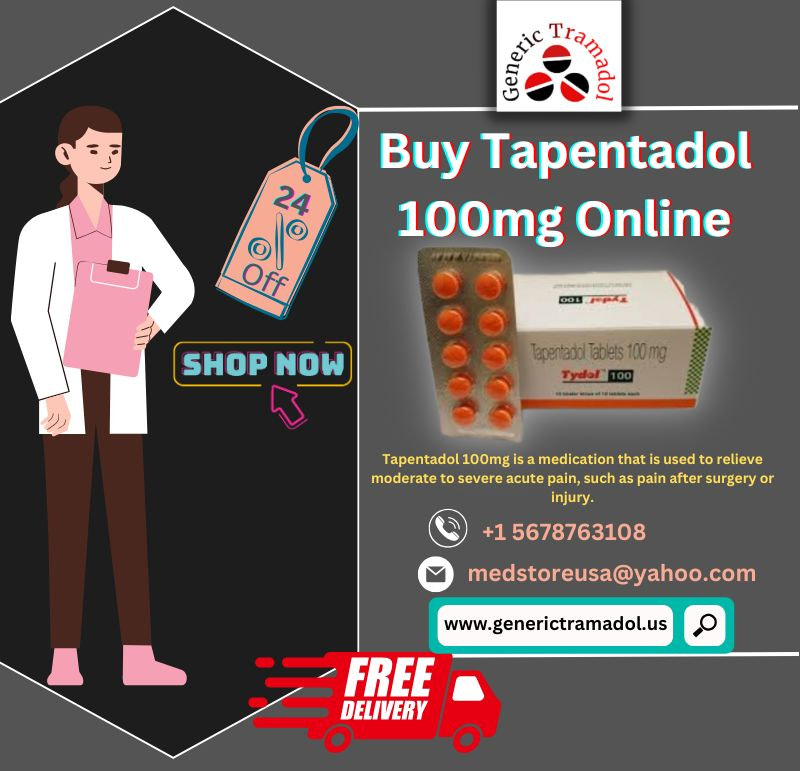Pain relief is one of the most critical components of modern medicine. For people suffering from moderate to severe pain, whether due to injury, surgery, or chronic illness, doctors often prescribe powerful medications to provide relief. Among the options available, Tapentadol 100mg has gained widespread attention for being safer and better tolerated compared to many traditional painkillers. But what exactly makes Tapentadol a less dangerous choice? Let’s explore the main factors in detail.
Understanding Tapentadol
Tapentadol is a centrally acting analgesic with a dual mechanism of action:
It acts as a mu-opioid receptor agonist, helping block pain signals in the brain.
It also works as a norepinephrine reuptake inhibitor (NRI), enhancing the body’s natural pain-fighting systems.
This unique dual mechanism is what makes Tapentadol distinct from traditional opioids like morphine, oxycodone, or codeine, which work only through the opioid pathway.
1. Dual Mechanism Means Lower Dosage Requirements
Because Tapentadol combines two methods of action, it can:
Reduce pain efficiently
Require smaller doses
Avoid opioid toxicity
Unlike stronger opioids that require higher doses for similar effects, Tapentadol achieves relief with less drug quantity, making it inherently safer.
2. Reduced Gastrointestinal Side Effects
One of the most common issues with pain medications—especially opioids—is gastrointestinal (GI) distress, which includes:
Constipation
Abdominal cramps
Appetite loss
Studies show that Tapentadol causes fewer GI side effects than morphine and oxycodone, which improves:
Patient adherence to treatment
Daily comfort and mobility
Long-term usability of the medication
3. Lower Risk of Respiratory Depression
Respiratory depression, or slowed breathing, is a life-threatening side effect of opioids. Tapentadol, due to its:
Moderate opioid receptor activation
Lower central nervous system suppression
Balanced mechanism with norepinephrine
…has shown less respiratory depression compared to high-dose opioids.
This makes it safer for:
People with respiratory illnesses
Individuals taking sedatives
Those without continuous monitoring
4. Less Cognitive and Sedative Impact
Traditional opioids often cause:
Excessive sedation
Mental fog
Dizziness
Tapentadol has demonstrated:
Fewer cognitive side effects
Lower sedation levels
Improved daytime functioning
As a result, patients using Tapentadol are better able to:
Continue working
Remain socially engaged
Preserve autonomy
5. Reduced Potential for Abuse and Dependency
Though Tapentadol is still classified as a Schedule II controlled substance, it exhibits a lower abuse potential compared to traditional opioids.
This is because:
It causes less euphoria
It produces a shorter high
It has a lower psychological reinforcement effect
Tapentadol is less attractive to recreational users and has a reduced risk of triggering addiction, especially when prescribed under proper supervision.
6. Improved Tolerability for Long-Term Use
People suffering from chronic conditions like:
Joint degeneration
Sciatica
Post-surgical complications
…require ongoing pain management. Traditional opioids often lead to:
Tolerance (needing higher doses over time)
Dependency
Side effects that worsen over time
Tapentadol’s dual mechanism reduces the need for dose escalation, making it more sustainable for long-term use.
7. Better for Nerve-Related Pain
Traditional opioids are less effective for neuropathic or nerve-related pain. Tapentadol’s norepinephrine reuptake inhibition helps with:
Tingling and burning sensations

Mixed pain syndromes
This makes Tapentadol a versatile option not just for nociceptive pain, but also for more complex pain types.
8. Fewer Drug Interactions and Simpler Dosing
Tapentadol is:
Not a prodrug (unlike tramadol, which needs liver activation)
Not metabolized heavily via CYP450 enzymes
Less likely to interact with common medications
This makes it safer for patients on:
Antidepressants
Elderly care regimens
Low kidney function
Additionally, it comes in:
Immediate release (IR) for acute pain
Extended release (ER) for chronic pain
Multiple strengths including 50mg, 100mg, 150mg, 200mg, 250mg
9. Clinical Support and Research Evidence
Research has confirmed Tapentadol’s efficacy and safety:
Comparable pain relief to morphine with better tolerability
Lower rates of treatment discontinuation due to side effects
Effective for both nociceptive and neuropathic pain
Its use is supported by guidelines for:
Post-operative care
Diabetes-related complications
Spine specialists
10. Ideal for Individualized Treatment
Tapentadol allows doctors to:
Tailor pain management strategies
Balance pain relief with cognitive preservation
Transition from other opioids smoothly
Its flexibility in both form and function makes it a go-to medication for many providers across disciplines.
Final Thoughts
This modern analgesic stands apart from traditional painkillers by offering:
Dual action for stronger pain control
Fewer side effects
Reduced dependency risk
Better outcomes in nerve-related and chronic pain
Wider tolerability across populations
As the medical world shifts toward safer, smarter pain solutions, tapentadol 100mg tablets online (superrxpharma.com) has proven itself to be a trustworthy, patient-friendly, and science-backed option. When prescribed responsibly, it can greatly improve the quality of life for those battling pain—without the baggage of older opioids.
